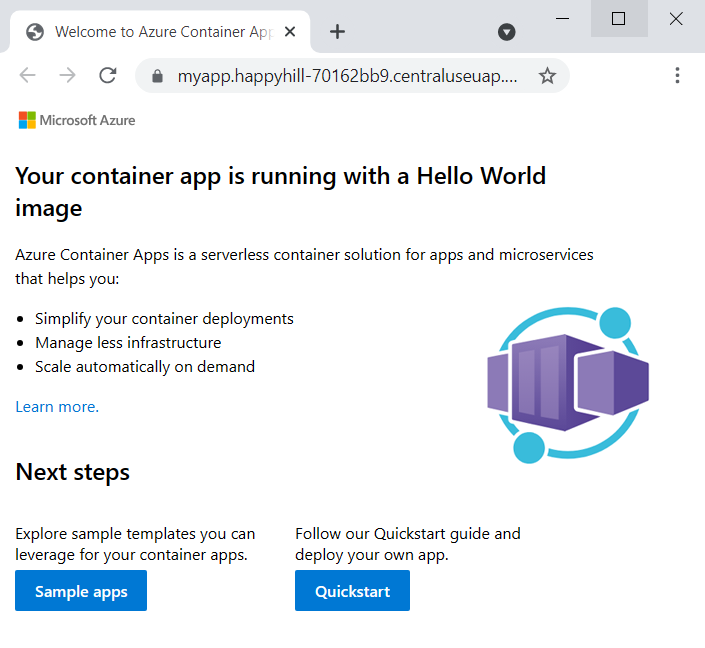Quickstart: Deploy your first container app using the Azure portal
Azure Container Apps enables you to run microservices and containerized applications on a serverless platform. With Container Apps, you enjoy the benefits of running containers while leaving behind the concerns of manually configuring cloud infrastructure and complex container orchestrators.
In this quickstart, you create a secure Container Apps environment and deploy your first container app using the Azure portal.
Prerequisites
An Azure account with an active subscription is required. If you don't already have one, you can create an account for free.
Register the
Microsoft.Appresource provider.
Setup
Begin by signing in to the Azure portal.
Create a container app
To create your container app, start at the Azure portal home page.
- Search for Container Apps in the top search bar.
- Select Container Apps in the search results.
- Select the Create button.
Basics tab
In the Basics tab, do the following actions.
Enter the following values in the Project details section.
Setting Action Subscription Select your Azure subscription. Resource group Select Create new and enter my-container-apps. Container app name Enter my-container-app.
Create an environment
Next, create an environment for your container app.
Select the appropriate region.
Setting Value Region Select Central US. In the Create Container Apps environment field, select the Create new link.
In the Create Container Apps Environment page on the Basics tab, enter the following values:
Setting Value Environment name Enter my-environment. Environment type Select Consumption only. Zone redundancy Select Disabled Select the Monitoring tab to create a Log Analytics workspace.
Select Azure Log Analytics as the Logs Destination.
Select the Create new link in the Log Analytics workspace field and enter the following values.
Setting Value Name Enter my-container-apps-logs. The Location field is prefilled with Central US for you.
Select OK.
Select the Container tab.
Check the box next to the Use quickstart image box.
Select the Create button at the bottom of the Create Container Apps Environment page.
Deploy the container app
Select Review and create at the bottom of the page.
If no errors are found, the Create button is enabled.
If there are errors, any tab containing errors is marked with a red dot. Navigate to the appropriate tab. Fields containing an error are highlighted in red. Once all errors are fixed, select Review and create again.
Select Create.
A page with the message Deployment is in progress is displayed. Once the deployment is successfully completed, you see the message: Your deployment is complete.
Verify deployment
Select Go to resource to view your new container app.
Select the link next to Application URL to view your application. The following message appears in your browser.

Clean up resources
If you're not going to continue to use this application, you can delete the Azure Container Apps instance and all the associated services by removing the resource group.
Select the my-container-apps resource group from the Overview section.
Select the Delete resource group button at the top of the resource group Overview.
Enter the resource group name my-container-apps in the Are you sure you want to delete "my-container-apps" confirmation dialog.
Select Delete.
The process to delete the resource group could take a few minutes to complete.
Tip
Having issues? Let us know on GitHub by opening an issue in the Azure Container Apps repo.
Next steps
Feedback
Coming soon: Throughout 2024 we will be phasing out GitHub Issues as the feedback mechanism for content and replacing it with a new feedback system. For more information see: https://aka.ms/ContentUserFeedback.
Submit and view feedback for